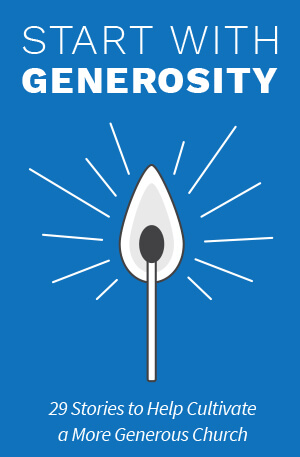10 Steps to Beat Your Church Budget and Increase Giving
Updated May 13, 2024 |
At the close of each year, your best-laid budget guesses from a year ago approach a moment of truth. Will this be a year of budget excess or of shortage? In our research with church attendees, we found one of the primary reasons why they hesitate to give to their church on a regular basis is a lack of trust. And let’s face it, even the most devout member will still have a moment of pause if they see their church’s “actual” giving number fall below the projected budget year after year. It becomes disheartening quite quickly.
To help reverse negative giving trends (unfortunately, studies tell us that 80–85 percent of churches are plateaued in terms of giving) we’ve put together a list of ten strategies to increase giving that we’ve seen work first hand in churches all across the world. To hear a more in-depth explanation of our strategy, check out our recorded video teaching: Growing a Generous Church—Your Next 100 Days.
Here are 10 steps to beat your church budget:
1. Establish a Baseline
Before you can move forward, you must gain a clear and accurate perspective of where you are currently. Establish a baseline of your generosity culture by asking some tough questions within your leadership team:
- How many times do we celebrate generosity from the pulpit?
- What percentage of the church is giving on a monthly basis?
- Has our giving per household gone up or down in the past 12 months?
- On a scale of 1–10, how generous do you think your church is?
- What would your surrounding community say?
Once you’ve identified the baseline giving culture within your church, it’s time to step through the process of creating sustainable cultural change.
Start with
Generosity
Learn how to cultivate a culture of generosity in your church.

2. Utilize Technology
Tools are just one piece of the generosity equation, but they are also the simplest part to implement and are a proven way to increase new givers and giving overall. In fact, when you sign up with Pushpay’s mobile giving, you’ll be guaranteed a 5 percent increase in your total annual giving, or we’ll refund your monthly software fees. Begin by analyzing your current digital/online giving against these three best practice benchmarks:
- Is your website and online giving form mobile responsive?
- Can someone give through their phone in 60 seconds or less the first time?
- After they’ve given once, do they have the ability to give in 10 seconds or less going foward?
Again, tools are not everything, but you never want outdated technology to stand in the way of someone making their first giving commitment.
3. Match Gifts on Your First Sunday
When you do implement your new mobile-friendly giving solution, generate excitement by matching a percentage of the first Sunday’s offering.
The reason matching gifts can be so effective is because it helps overcome the, “I’ll do it later,” excuse. In this moment, if they give for the first time, their gift will be doubled.
4. Issue a Personal Generosity Challenge
Next, gather your core leadership team together to ask and answer these two questions:
- Do you personally tithe every month?
- How transparent are you about your generosity journey?
While potentially uncomfortable, if you are serious about beating your church budget and increasing generosity, conversations such as these are mandatory. Stay away from guilt, and tread lightly with the word “accountability,” instead focus on open and honest dialogue. Lead by example and be the first person to answer the questions.
Once asked, then issue a personal generosity challenge to each person in the group. Here are a few things to keep in mind with your challenges:
- Include elements of transparency and share your own struggles
- Be goal driven
- Consider non-financial opportunities
5. Consistent Messaging
Consistency leads to participation. And participation is the key to the thing we all want from our faith communities: Sustainability.
Be consistent in your giving talks about the ways to give, the way the money is being spent, and the impact the gifts are having to the Kingdom.
6. Celebrate Generosity Publicly
The old adage is true: what your church celebrates most will become what your church values most. Take the time to celebrate life change caused by generosity. Use personal testimonies to spur excitement and encourage future acts. Your time in service is in short supply, therefore the things you discuss during this time take on a high value by association.
7. Random Acts of Generosity
Carrying forward the motivation gained from the personal generosity challenges issued to your core leadership team, begin to demonstrate random acts of generosity throughout your church community. This step is powerful because it helps create a new perspective, one where your leaders are not waiting for someone to ask, instead they are actively seeks out opportunities to be generous. This is a huge paradigm shift.
8. Teaching Series on Generosity
Notice how far down the list this step falls? We intentionally saved this strategy until the end, as it is unfortunately the go-to tactic when facing a church budget crisis. Here’s a powerful truth, it’s not healthy for pastors to speak about finances only when the church is in need. Teach on finances once you’ve completed the seven previous steps, not before. When it is time for your series, here’s a sample generosity curriculum to get you started.
9. Adjust Your Internal Language
All culture change requires an update to our vocabulary. Make a commitment as a leadership team to adjust your internal language. Make it positive, rather than negative. Be redemptive, rather than judgmental. And, get creative with the titles you use. For example, instead of Welcoming Committee, Acts 2 United Methodist Church calls it the Radical Hospitality Team.
10. Cast a Compelling Future Vision
End-of-year letters and annual reports are the perfect vehicles to launch your future vision through. Intentionally design them to paint a picture of the generosity growth within your congregation, and you will be planting seeds of excitement for the year to come. Here’s a great example from Chase Oaks church for you to take a look at.
In addition, part of casting future vision is giving regular status updates of current stewardship initiatives. At a bare minimum, you’ll want to be transparent in the following areas:
- Where did the money go?
- What ministry work was accomplished as a result?
- Where did you fall short and what cut backs had to be made as a result?
- Where did you exceed?
The Everygift™ Impact
Everygift is Pushpay’s promise that nothing will come between you and your donors’ desire to give.

Featured Content
You May Also Like
